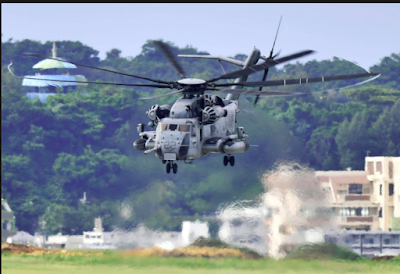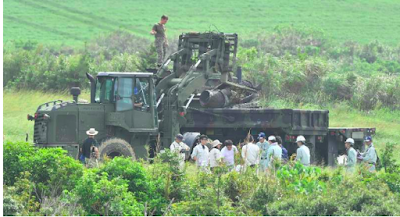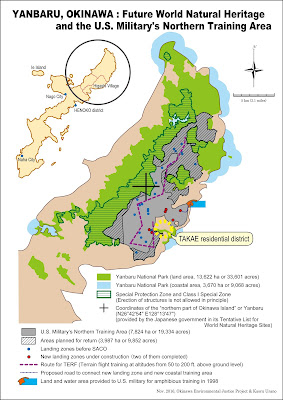The U.S Military Resumes CH-53 Flight Operations and Issues (Damage Control) Media Release
While the residents of the Takae district, Higashi village and the people of Okinawa are still shaken and infuriated by the October 11 crash of a U.S
military CH-53 helicopter in the district, and although the cause of the crash has not been determined, the U.S. military resumed the flight
operations of the aircraft on October 18. See Kyodo News.
Following a 96-hour suspension of flight operations, the U.S. military’s CH-53 helicopters are back in the Okinawa sky, flying over our houses, schools, hospitals, forests and sea as if nothing has happened.
Following a 96-hour suspension of flight operations, the U.S. military’s CH-53 helicopters are back in the Okinawa sky, flying over our houses, schools, hospitals, forests and sea as if nothing has happened.
 |
| ©KYODO |
The Japanese government, Okinawa prefectural government and local
municipalities have demanded that the operations of the CH-53 aircraft be suspended indefinitely until the cause of the crash is determined, but to no avail. See The Japan Times.
U.S. Military’s Media Release
Before resuming the operation of CH-53 helicopters, the U.S. military issued a
media release, providing explanations for its actions. See the Media Release.
In our opinion, the media release reads like a damage control PR statement, directed to (the rest of) the U.S. military and U.S. government and probably to the U.S. public, but not to the people of Okinawa (It is written in English and we have
not seen a Japanese translation of it yet).
It states:
“Aviation experts have conducted a thorough
review of the maintenance records and found no issues with the standard
maintenance practices, actions, technical directives, periodic inspections and
no operational matters to warrant concern.”
“The Commanding General,
Marine Corps Forces Japan, Lt. Gen. Lawrence D. Nicholson, is satisfied that
the CH-53E aircraft is prepared to return to safe flight operations.”
“This decision is not
taken lightly, and was only decided upon following consultation with 1st Marine
Aircraft Wing aviation professionals, and subject matter experts from the U.S.
Naval Safety Center who arrived on Okinawa from the continental United States
to assist in the overall investigation.”
Apparently, conducting “a thorough
review of the maintenance records” (underline added) and fining "no issues" in the review were enough
to resume CH-53 flight operations.
Since we are no aviation experts,
we are not in a position to make a judgment about the U.S. military’s review process or decisions per se. Still, we can point out that we have not seen any report
or written document from the military's “aviation experts” substantiating what the U.S. military claims in the media release.
"Working Closely" with Who?
What concerns us the most is the misleading nature of the media release.
It states that “Working closely with
Government of Japan and local officials, we are conducting salvage and recovery
operations of the aircraft quickly and safely to return the land as soon as
possible.”
However, the Okinawa prefectural
government and the Okinawa prefectural police force (and possibly the Japanese government) were all
denied by the U.S. military access to the crash site to conduct investigation, apparently in accordance with the Japan-US Status of Forces Agreement, when the crash took place. See The Japan Times.
It was only more than a week later the crash or after the U.S. military had salvaged the burned CH-53 and its debries and had removed away the surface soil of the crash site (without the land owner’s consent and despite the Okinawa police force’s request not to do so) that the Japanese and Okinawa governments were given access to conduct investigation. See The Okinawa Times (in Japanese). Okinawa Governor Takeshi Onaga and his prefectural government are infuriated with the way the U.S. military has been handling the case.
 |
| ©The Okinawa Times |
Thus, it is
hard to be convinced by the U.S. military claim that it is “working closely with Government of Japan and
local officials” unless the words “working closely” now mean “forcing one's action upon someone else."
And, how much information
could the Okinawa prefectural governments and the prefectural
police force get from their site investigation now?
"Sharing Information"?
It is no doubt that the U.S.
military is better equipped to conduct investigation on military accidents such
as this case than the Japanese government, the Okinawa prefectural
government and the prefectural police force are. In this regard, we hope that the U.S. military is conducting
a thorough and transparent investigation on the case and will be forthcoming with
the results.
We are alarmed however
when the U.S. military’s media release states that “We will continue to share
information with the government of Japan as details become available and in
accordance with the Status of Forces Agreement.”
In Okinawa, the Japanese
government has been known to withhold from the public information
relating to U.S. military bases and facilities even when the U.S. military provides
it.
For example, the Japanese
government withheld information on the deployment of MV-22 Ospreys to Okinawa
and information on the flight routes of aircrafts expected to operate at a
proposed military base and on the construction plan of a 214-meter wharf at in Henoko-Oura Bay, as long as it could to get what it wanted. See The Japan Times.
In the past, in fact, the extent to which the
Japanese government tried to withhold information was so alarming that the U.S.
military claimed in a memorandum that “the JDA [Japan Defense Agency]
appeared adamant that they did not want to depict flight paths over land” and
that “ the US feels the need to be open with the local Okinawans because
their acceptance of the plan is tied to the operational requirement of building
the airfield.” See this Asia Pacific Journal: Japan Focus article.
Thus, the U.S. military’s assertion
that it “will continue to share information with the government of Japan as
details become available” does not give assurance or comfort to the people
of Okinawa. Instead, it just alarms us more.
Access to information,
Public Participation and Access to Justice
As the Aarhus Convention
affirms (See this site), the protection of the environment requires
the so-called three pillars: “access to information,” “public participation in
decision-making,” and “access to justice in environmental matters.”
In
Okinawa, as illustrated above, these three pillars remain as illusive as ever when
U.S. military is involved. (Besides, the Japanese government has not ratified
the Aarhus Convetion for whaever reason.)
Still,
we have to keep fighting to gain
and secure the rights to “access
to information,” “public participatin in decision-making,” and “access to
justice in environmetal matters.”
We need and welcome your support for our fight!

